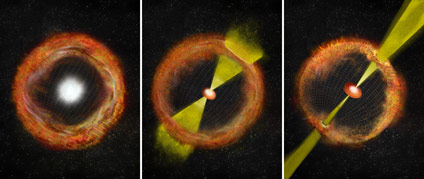
"This is a striking result that provides a key insight about the mechanism underlying these explosions," said Sayan Chakraborti, of the Harvard-Smithsonian Center for Astrophysics (CfA). "This object fills in a gap between GRBs and other supernovae of this type, showing us that a wide range of activity is possible in such blasts," he added.
The object, called Supernova 2012ap (SN 2012ap) is what astronomers term a core-collapse supernova. This type of blast occurs when the nuclear fusion reactions at the core of a very massive star no longer can provide the energy needed to hold up the core against the weight of the outer parts of the star. The core then collapses catastrophically into a superdense neutron star or a black hole. The rest of the star's material is blasted into space in a supernova explosion.
Read the full story at NRAO News

